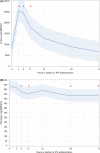MUlticenter STudy of tissue plasminogen activator (alteplase) use in COVID-19 severe respiratory failure (MUST COVID): A retrospective cohort study
- PMID: 35341072
- PMCID: PMC8935535
- DOI: 10.1002/rth2.12669
MUlticenter STudy of tissue plasminogen activator (alteplase) use in COVID-19 severe respiratory failure (MUST COVID): A retrospective cohort study
Abstract
Background: Few therapies exist to treat severe COVID-19 respiratory failure once it develops. Given known diffuse pulmonary microthrombi on autopsy studies of COVID-19 patients, we hypothesized that tissue plasminogen activator (tPA) may improve pulmonary function in COVID-19 respiratory failure.
Methods: A multicenter, retrospective, observational study of patients with confirmed COVID-19 and severe respiratory failure who received systemic tPA (alteplase) was performed. Seventy-nine adults from seven medical centers were included in the final analysis after institutional review boards' approval; 23 were excluded from analysis because tPA was administered for pulmonary macroembolism or deep venous thrombosis. The primary outcome was improvement in the PaO2/FiO2 ratio from baseline to 48 h after tPA. Linear mixed modeling was used for analysis.
Results: tPA was associated with significant PaO2/FiO2 improvement at 48 h (estimated paired difference = 23.1 ± 6.7), which was sustained at 72 h (interaction term p < 0.00). tPA administration was also associated with improved National Early Warning Score 2 scores at 24, 48, and 72 h after receiving tPA (interaction term p = 0.00). D-dimer was significantly elevated immediately after tPA, consistent with lysis of formed clot. Patients with declining respiratory status preceding tPA administration had more marked improvement in PaO2/FiO2 ratios than those who had poor but stable (not declining) respiratory status. There was one intracranial hemorrhage, which occurred within 24 h following tPA administration.
Conclusions: These data suggest tPA is associated with significant improvement in pulmonary function in severe COVID-19 respiratory failure, especially in patients whose pulmonary function is in decline, and has an acceptable safety profile in this patient population.
© 2022 The Authors. Research and Practice in Thrombosis and Haemostasis published by Wiley Periodicals LLC on behalf of International Society on Thrombosis and Haemostasis (ISTH).
Figures




References
-
- Acute Respiratory Distress Syndrome Network , Brower RG, Matthay MA, et al. Ventilation with lower tidal volumes as compared with traditional tidal volumes for acute lung injury and the acute respiratory distress syndrome. N Engl J Med. 2000;342(18):1301‐1308. - PubMed
-
- Guerin C, Reignier J, Richard JC, et al. Prone positioning in severe acute respiratory distress syndrome. N Engl J Med. 2013;368(23):2159‐2168. - PubMed
Grants and funding
LinkOut - more resources
Full Text Sources

